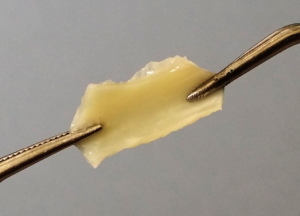Fibrous proteins, also known as scleroproteins, belong to one of the three major proteins (along with globular and membrane proteins). Long or fibrous polypeptide chains generate constructions made up of filaments and sheets in fibrous proteins. Following are list fibrous protein example:
- Keratin
- Spider silk
- Collagen
- Type I Collagen
- Type II Collagen
- Type III Collagen
- Type IV Collagen
- Type V Collagen
- Elastin
- Fibrin
- Laminins
- Fibroin
- Silk I
- Silk II
- Silk III
- Myosin
Keratin
Keratin is a structurally fibrous protein that originates to the scleroprotein category. In vertebrates, alpha-keratin (-keratin) is a kind of keratin. This material is found in scales, hair, nails, hooves, feathers, horns, claws and the outer layer of skin in vertebrates.
Spider silk
Although spider silk is classed as keratin, the protein’s synthesis may have developed independently of vertebrate silk production.
Functions:
Chitin is perhaps the only biological substance that may approximate the hardness of keratinized tissue. Keratin also helps to protect epithelial cells from damages and stress.

Collagen
Collagen is the most essential structural protein in the extracellular environment, and it may be observed in all connective cells around the body. It contributes for 25 to 35 percent of total protein levels in animals, making it the most frequent protein.
Type I Collagen
Organs, bone, skin, tendon, vasculature (major component of the bone’s organic part)
Type II Collagen
Cartilage (cartilage’s major collagenous component)
Type III Collagen
Reticulate (the major component of reticular fibres) is a form of reticular fibre that is usually seen alongside type I.
Type IV Collagen
The basement membrane’s epithelium-secreted layer, basal lamina, is formed.
Type V Collagen
Hair, placenta and cell surfaces
Functions
It offers structural support to connective tissue’s extracellular space. It’s the ideal array for epidermis, tendons, ligaments, and bones because of its hardness and resistance to stretching.

Elastin
The ELN gene in humans translates for the protein elastin. In gnathostomes, elastin is an important extracellular matrix component (jawed vertebrates). It’s present in connective tissue and is very flexible, permitting many tissues in the body to revert to their former shape after being stretched or constricted.
When skin is poked or squeezed, elastin helps it restore its natural place. Elastin is a load-bearing tissue found in vertebrates’ bodies and is employed in locations where mechanical energy must be stored. Elastin is expressed by the ELN gene in humans.
Function:
Two elements are involved in elastic fibres, one of which is transcribed by the ELN gene. Hydrophobic amino acids like glycine and proline are abundant in the encoded protein, forming mobile hydrophobic areas bordered by crosslinks between lysine residues.

Fibrin
Fibrin (sometimes referred to as Factor Ia) is a fibrous, non-globular protein that aids in the clotting of blood. This material is formed when the protease thrombin acts on fibrinogen, causing it to polymerize. Polymerized fibrin forms a hemostatic plug or clot over a wound site when it joins forces with platelets.

Functions
Fibrin (also known as Factor Ia) is now a fibrous protein that helps blood clot. The effect of the enzyme protease thrombin on fibrinogen leads it to polymerize, resulting in this substance.
Laminins
Laminins are extracellular matrix proteins with a large molecular weight (400 to 900 kDa). They make up a large component of the basal lamina (one of the basement membrane’s layers), which acts as a protein network foundation for the most cells and organs.
The laminins, which influence cell differentiation, migration, and adhesion, are a significant and physiologically active basal lamina component.

Function:
Entactin, fibronectin, and perlecan link laminins to type IV collagen networks, forming separate networks. They also bind cell membranes with integrin receptors and other plasma membrane molecules such as the dystroglycan glycoprotein complex and Lutheran blood group glycoprotein.
Fibroin
Fibroin is an insoluble protein present in the silk of Bombyx mori larvae and other moth species such as Antheraea, Cricula, Samia, and Gonometa. Silk comprises two primary proteins, sericin, and fibroin, with a glue-like covering of sericin wrapping two unique fibroin filaments termed brins in their raw condition.
Silk I
Silk I is the naturally occurring chemical form of fibroin produced by the silk glands of Bombyx mori.
Silk II
Silk II describes the set of fibroin units in spun silk, which is stronger and more commonly utilised in commercial applications.
Silk III
Silk III is a recently found fibroin structure. Silk III is mostly generated at an interface in fibroin solutions (i.e. air-water interface, water-oil interface, etc.).
Functions
Fibroin was already widely employed in the production of medicinal materials. Silk peptides can be isolated from silkworm cocoons or silk glands.
Myosin
Myosins are a group of motor proteins that play a key role in muscle movement and a variety of other eukaryotic motility events. They constitute ATP-dependent and are in control of motility based on actin.
Functions:
Multiple myosin II molecules work together to produce movement in skeletal muscle via a power stroke process powered by ATP hydrolysis energy.
Conclusion:
In the above article, we studied about different types fibrous proteins including Collagen, Keratin, Elastin, Fibrin, Myosin, Fibroin, Laminins and different properties related to these fibrous proteins.
Also Read:
- Chromosome and centrosome
- Is cell wall made of cellulose
- Channel proteins
- Nonvascular plants examples
- Do eukaryotic cells have ribosomes
- Carrier proteins in facilitated diffusion
- Is coenzyme molecule
- Exotic species examples
- Adenine function in rna
- Do bacteria have flagella
Hi….I am Ganeshprasad DN, completed my Ph.D. in Biochemistry from Mangalore University, I intend to use my knowledge and technical skills to further pursue research in my chosen field.